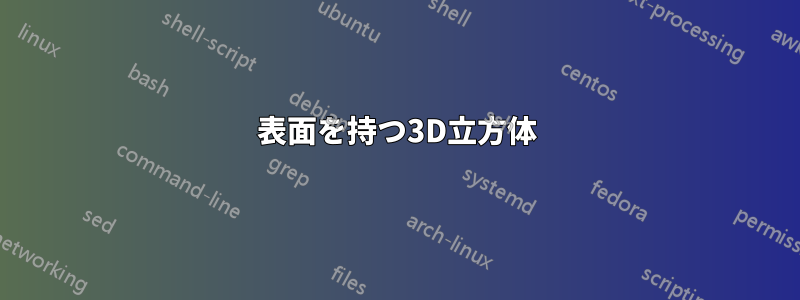
ここに示すように、原子の配置を示す単位殻を描きたいと思います。(Zumdahl、Chemical Principles、第 5 版、Houghton Mifflin、p. 773。)


原子面 (上の立方体) を描く次のコードを思いつきました。立方体の面を一度定義するだけで、それを傾斜させて他の面を描画できるという考え方を採用しています。ただし、シェーディング (切り取られた球) を (数学的に) 描画する方法がわかりません。何か提案はありますか?
可能であれば、キュービクルの 1 つの側面のみを定義するというアイデアを使用してください。これは、上記のすべての例と、場合によってはそれ以上の例 (例に 2 つの面を追加しました) を描画する必要があるため、非常に便利です。ただし、これが不可能な場合は、他のソリューションが推奨されます。ソリューションを回転させることはできません。
\documentclass{minimal}
\usepackage{tikz}
\begin{document}
\begin{tikzpicture}
\pgfmathsetmacro{\D}{4}
\pgfmathsetmacro{\halfD}{\D/2}
\newcommand{\mycubicleface}{
\pgfmathsetmacro{\R}{\D/2}
\draw [fill=blue!30] (0,\R) arc [start angle=90, end angle=0, radius=\R] -- +(-\R,0);
\draw [fill=blue!30] (0,\R) arc [start angle=-90, end angle=0, radius=\R] -- +(-\R,0);
\draw [fill=blue!30] (\D,\R) arc [start angle=-90, end angle=-180, radius=\R] -- +(\R,0);
\draw [fill=blue!30] (\D,\R) arc [start angle=90, end angle=180, radius=\R] -- +(\R,0);
\draw (0,0) rectangle +(\D,\D);
}
%\newcommand{\mycubicleface}{
% \pgfmathsetmacro{\R}{\D/sqrt(8)}
% \draw [fill=blue!30] (\D/2,\D/2) circle [radius=\R];
% \draw [fill=blue!30] (0,\R) arc [start angle=90, end angle=0, radius=\R] -- +(-\R,0);
% \draw [fill=blue!30] (0,\D - \R) arc [start angle=-90, end angle=0, radius=\R] -- +(-\R,0);
% \draw [fill=blue!30] (\D,\D - \R) arc [start angle=-90, end angle=-180, radius=\R] -- +(\R,0);
% \draw [fill=blue!30] (\D,\R) arc [start angle=90, end angle=180, radius=\R] -- +(\R,0);
% \draw (0,0) rectangle +(\D,\D);
%}
\begin{scope}[yslant=-.5]
\mycubicleface
\end{scope}
\begin{scope}[xshift=\D cm, yshift=-\halfD cm, yslant=.5]
\mycubicleface
\end{scope}
\begin{scope}[xshift=\D cm, yshift=\halfD cm, yslant=.5, xslant=-1]
\mycubicleface
\end{scope}
\end{tikzpicture}
\end{document}
答え1
これは結果の反対部分です。
このアイデアはこの例球体上にいくつかの経線/緯度円を描きます。これらの円弧を描く代わりに、クリッピング パスとして使用します。いくつかの作品アークを接続するために必要です。

\documentclass[tikz]{standalone}
\usepackage{tikz,spath}
\usetikzlibrary{calc,fadings}
\newcommand\pgfmathsinandcos[3]{
\pgfmathsetmacro#1{sin(#3)}\pgfmathsetmacro#2{cos(#3)}}
\newcommand\LongitudePlane[3][current plane]{
\pgfmathsinandcos\sinEl\cosEl{#2}\pgfmathsinandcos\sint\cost{#3}
\tikzset{#1/.style={cm={\cost,\sint*\sinEl,0,\cosEl,(0,0)}}}}
\newcommand\LatitudePlane[3][current plane]{%
\pgfmathsinandcos\sinEl\cosEl{#2}\pgfmathsinandcos\sint\cost{#3}
\pgfmathsetmacro\yshift{\cosEl*\sint}
\tikzset{#1/.style={cm={\cost,0,0,\cost*\sinEl,(0,\yshift)}}}}
\newcommand\ClipLongitudeCircle[2]{
\LongitudePlane\angEl{#1}
\pgfmathsetmacro\angVis{atan(sin(#1)*cos(\angEl)/sin(\angEl))}
\path[save path=\tmppath,current plane](\angVis:\R)arc(\angVis:\angVis+180:\R);
\pgfoonew\patha=new spath(\tmppath)
\pgfmathsetmacro\angVis{-atan(sin(\angEl)*cos(#1)/sin(#1))}
\path[save path=\tmppath](-90+\angVis:\R)arc(-90+\angVis:#2180-90+\angVis:\R);
\pgfoonew\pathb=new spath(\tmppath)
\patha.concatenate with lineto(,\pathb)\patha.close()\patha.use path with tikz(clip)}
\newcommand\ClipLatitudeCircle[2]{
\LatitudePlane{\angEl}{#1}
\path[save path=\tmppath,current plane](-180:\R)arc(-180:0:\R);
\pgfoonew\patha=new spath(\tmppath)
\path[save path=\tmppath](0:\R)arc(0:#2180:\R);
\pgfoonew\pathb=new spath(\tmppath)
\patha.concatenate with lineto(,\pathb)\patha.close()\patha.use path with tikz(clip)}
\newcommand\EighthSphere[3]{
\ClipLongitudeCircle{45-\angPh}{#1}
\ClipLongitudeCircle{135-\angPh}{#2}
\ClipLatitudeCircle{0}{#3}
\fill[ball color=white](0,0)circle(\R);}
\begin{document}
\def\R{6} % sphere radius
\def\angEl{20} % elevation angle in interval [1,89]
\def\angPh{10} % phase angle in interval [-44,44]
\pgfmathsetmacro\uofx{cos(-135-\angPh)}
\pgfmathsetmacro\vofx{sin(-135-\angPh)*sin(\angEl)}
\pgfmathsetmacro\uofy{cos(-45-\angPh)}
\pgfmathsetmacro\vofy{sin(-45-\angPh)*sin(\angEl)}
\pgfmathsetmacro\uofz{0}
\pgfmathsetmacro\vofz{cos(\angEl)}
\begin{tikzpicture}
\begin{scope}[x={(\uofx cm,\vofx cm)},y={(\uofy cm,\vofy cm)},z={(\uofz cm,\vofz cm)}]
\path(-6,-6,-6)coordinate(A){}(6,6,6)coordinate(B){};
\path(6,-6,-6)coordinate(P){}(6,6,-6)coordinate(Q){}(-6,6,-6)coordinate(R){}
(-6,6,6)coordinate(S){}(-6,-6,6)coordinate(T){}(6,-6,6)coordinate(U){};
\end{scope}
\path(-12,-12)(12,12);
\draw(P)--(Q)--(R)--(S)--(T)--(U)--cycle;
\clip(P)--(Q)--(R)--(S)--(T)--(U)--cycle;
\begin{scope}[transform canvas={shift=(A)}]
\EighthSphere{+}{-}{+}
\end{scope}
\begin{scope}[transform canvas={shift=(P)}]
\EighthSphere{+}{+}{+}
\end{scope}
\begin{scope}[transform canvas={shift=(R)}]
\EighthSphere{-}{-}{+}
\end{scope}
\begin{scope}[transform canvas={shift=(T)}]
\EighthSphere{+}{-}{-}
\end{scope}
\begin{scope}[transform canvas={shift=(Q)}]
\EighthSphere{-}{+}{+}
\end{scope}
\begin{scope}[transform canvas={shift=(S)}]
\EighthSphere{-}{-}{-}
\end{scope}
\begin{scope}[transform canvas={shift=(U)}]
\EighthSphere{+}{+}{-}
\end{scope}
\end{tikzpicture}
\end{document}
答え2
ついに完成です! 次のコードをコメント化したりコメント解除したりすることで、3 つのキューブすべてを作成できます。
答えは基本的にシンボル1の答え、変更のみ。spathパッケージを手動でインストールする必要があることに注意してくださいここでお知らせした通り。
コード内のコメント部分はデバッグ用です (クリップするパスの描画)。
最終結果は満足のいくものです。ただし、2 つの半球を含む中央の画像のスタッキングとシェーディングが間違っていることに注意してください。

\documentclass[tikz]{standalone}
\usepackage{spath}
\usepackage{tikz}
\usetikzlibrary{calc}
\usetikzlibrary{fadings}
\begin{document}
% Source: LaTeX-Community.org
% <http://www.latex-community.org/viewtopic.php?f=4&t=2111>
\begin{tikzpicture}
\newcommand\pgfmathsinandcos[3]{%
\pgfmathsetmacro#1{sin(#3)}%
\pgfmathsetmacro#2{cos(#3)}%
}
\newcommand\LongitudePlane[3][current plane]{%
\pgfmathsinandcos\sinEl\cosEl{#2} % elevation
\pgfmathsinandcos\sint\cost{#3} % azimuth
\tikzset{#1/.style={cm={\cost,\sint*\sinEl,0,\cosEl,(0,0)}}}
}
\newcommand\LatitudePlane[3][current plane]{%
\pgfmathsinandcos\sinEl\cosEl{#2} % elevation
\pgfmathsinandcos\sint\cost{#3} % latitude
\pgfmathsetmacro\yshift{\cosEl*\sint}
\tikzset{#1/.style={cm={\cost,0,0,\cost*\sinEl,(0,\yshift)}}}
}
%\newcommand\DrawLongitudeCircle[2][4]{
% \LongitudePlane{\angEl}{#2}
%% \tikzset{current plane/.prefix style={scale=#1}}
% % angle of "visibility"
% \pgfmathsetmacro\angVis{atan(sin(#2)*cos(\angEl)/sin(\angEl))}
% \draw[current plane, blue] (\angVis:\R) arc (\angVis:\angVis+180:\R);
% \draw[current plane, blue] (\angVis-180:\R) arc (\angVis-180:\angVis:\R);
%}
%\newcommand\DrawLatitudeCircle[2][5]{
% \LatitudePlane{\angEl}{#2}
%% \tikzset{current plane/.prefix style={scale=#1}}
%% \pgfmathsetmacro\sinVis{sin(#2)/cos(#2)*sin(\angEl)/cos(\angEl)}
%% % angle of "visibility"
%% \pgfmathsetmacro\angVis{asin(min(1,max(\sinVis,-1)))}
% \draw[current plane, red] (\angVis:\R) arc (\angVis:-\angVis-180:\R);
% \draw[current plane, red] (180-\angVis:\R) arc (180-\angVis:\angVis:\R);
%}
\newcommand\ClipLongitudeCircle[2]{
\LongitudePlane{\angEl}{#1}
\pgfmathsetmacro\angVis{atan(sin(#1)*cos(\angEl)/sin(\angEl))}
\path[save path=\tmppath, current plane] (\angVis:\R) arc (\angVis:\angVis+180:\R); % current plane transformation
\pgfoonew\patha=new spath(\tmppath)
\pgfmathsetmacro\angVis{-atan(sin(\angEl)*cos(#1)/sin(#1))}
\path[save path=\tmppath] (-90+\angVis:\R) arc (-90+\angVis:#2 180-90+\angVis:\R); % no coordinate transform (no current plane)
\pgfoonew\pathb=new spath(\tmppath)
\patha.concatenate with lineto(,\pathb)
\patha.close()
\patha.use path with tikz(clip)
% \patha.use path with tikz(fill=magenta, opacity=.2)
% \patha.use path with tikz(draw=magenta, very thick)
}
\newcommand\ClipLatitudeCircle[2]{
\LatitudePlane{\angEl}{#1}
\path[save path=\tmppath,current plane] (-180:\R) arc (-180:0:\R);
\pgfoonew\patha=new spath(\tmppath)
\path[save path=\tmppath] (0:\R) arc (0:#2 180:\R);
\pgfoonew\pathb=new spath(\tmppath)
\patha.concatenate with lineto(,\pathb)
\patha.close()
\patha.use path with tikz(clip)
% \patha.use path with tikz(fill=cyan, opacity=.2)
% \patha.use path with tikz(draw=cyan, very thick)
}
\newcommand\ClippedEightSphere[4]{
\begin{scope}[transform canvas={shift=(#4)}]
\ClipLongitudeCircle{45-\angPh}{#1}
\ClipLongitudeCircle{135-\angPh}{#2}
\ClipLatitudeCircle{0}{#3}
\fill[ball color=white] (0,0) circle (\R);
\end{scope}}
\newcommand\ClippedLatitudeSphere[3]{
\begin{scope}[transform canvas={shift=(#1)}]
\LatitudePlane{\angEl}{#2}
\ClipLatitudeCircle{0}{#3}
\fill[ball color=white] (0,0) circle [radius=\R];
\end{scope}}
\newcommand\ClippedLongitudeSphere[3]{
\begin{scope}[transform canvas={shift=(#1)}]
\LongitudePlane{\angEl}{#2}
\ClipLongitudeCircle{#2}{#3}
\fill[ball color=white] (0,0) circle [radius=\R];
\end{scope}}
\newcommand\DrawLongitudeArc[4]{
\LongitudePlane{\angEl}{#2}
\begin{scope}[current plane, transform canvas={shift=(#1)}]
\fill [cyan] (0,0) -- ++(#3:\R) arc [start angle=#3, delta angle=#4, radius=\R] -- cycle;
\draw ++(#3:\R) arc [start angle=#3, delta angle=#4, radius=\R];
\end{scope}}
\newcommand\DrawLatitudeArc[4]{
\LatitudePlane{\angEl}{#2}
\begin{scope}[current plane, transform canvas={shift=(#1)}]
\fill [cyan] (0,0) -- ++(#3:\R) arc [start angle=#3, delta angle=#4, radius=\R] -- cycle;
\draw ++(#3:\R) arc [start angle=#3, delta angle=#4, radius=\R];
\end{scope}}
\def\D{8} % cubic side length
% \pgfmathsetmacro\R{\D/2} % sphere radius
\pgfmathsetmacro\R{sqrt(2)/4*\D} % sphere radius
% \pgfmathsetmacro\R{sqrt(3)/4*\D} % sphere radius
\def\angEl{20} % elevation angle in interval [1,89]
\def\angPh{10} % phase angle in interval [-44,44]
\pgfmathsetmacro\uofx{cos(-135-\angPh)}
\pgfmathsetmacro\vofx{sin(-135-\angPh)*sin(\angEl)}
\pgfmathsetmacro\uofy{cos(-45-\angPh)}
\pgfmathsetmacro\vofy{sin(-45-\angPh)*sin(\angEl)}
\pgfmathsetmacro\uofz{0}
\pgfmathsetmacro\vofz{cos(\angEl)}
% The coordinates of the cube
\begin{scope}[x={(\uofx cm,\vofx cm)}, y={(\uofy cm,\vofy cm)}, z={(\uofz cm,\vofz cm)}]
\coordinate (C1) at (\D,0,0);
\coordinate (C2) at (\D,0,\D);
\coordinate (C3) at (0,0,\D);
\coordinate (C4) at (0,\D,\D);
\coordinate (C5) at (0,\D,0);
\coordinate (C6) at (\D,\D,0);
\coordinate (C7) at (0,0,0);
\coordinate (C8) at (\D,\D,\D);
% \foreach \n in {1,2,...,8} \node at (C\n) {C\n};
\coordinate (C0) at ($(C2)!.5!(C5)$);
\coordinate (S1) at ($(C2)!.5!(C6)$);
\coordinate (S2) at ($(C2)!.5!(C4)$);
\coordinate (S3) at ($(C8)!.5!(C5)$);
\coordinate (S4) at ($(C6)!.5!(C7)$);
\coordinate (S5) at ($(C1)!.5!(C3)$);
\coordinate (S6) at ($(C5)!.5!(C3)$);
\end{scope}
% Draw the clipped spheres
\ClippedEightSphere{+}{-}{+}{C7}
\ClippedLongitudeSphere{S5}{45-\angPh}{+}
\ClippedLongitudeSphere{S6}{135-\angPh}{-}
\ClippedLatitudeSphere{S4}{0}{+}
\ClippedEightSphere{-}{+}{-}{C8}
\ClippedEightSphere{+}{-}{-}{C3}
\ClippedEightSphere{+}{+}{-}{C2}
% \fill[ball color=white] (C0) circle [radius=\R];
\ClippedEightSphere{-}{-}{-}{C4}
\ClippedEightSphere{+}{+}{+}{C1}
\ClippedEightSphere{-}{-}{+}{C5}
\ClippedEightSphere{-}{+}{+}{C6}
% Draw the half spheres
\ClippedLatitudeSphere{S2}{0}{-}
\ClippedLongitudeSphere{S3}{45-\angPh}{-}
\ClippedLongitudeSphere{S1}{135-\angPh}{+}
\DrawLatitudeArc{S2}{0}{0}{360}
\DrawLongitudeArc{S1}{135-\angPh}{0}{360}
\DrawLongitudeArc{S3}{45-\angPh}{0}{360}
% Draw the Arcs
\DrawLongitudeArc{C1}{135-\angPh}{90}{90}
\DrawLongitudeArc{C2}{135-\angPh}{-90}{-90}
\DrawLongitudeArc{C4}{45-\angPh}{-90}{-90}
\DrawLongitudeArc{C5}{45-\angPh}{90}{90}
\DrawLongitudeArc{C6}{135-\angPh}{90}{-90}
\DrawLongitudeArc{C6}{45-\angPh}{90}{-90}
\DrawLongitudeArc{C8}{135-\angPh}{-90}{90}
\DrawLongitudeArc{C8}{45-\angPh}{-90}{90}
\DrawLatitudeArc{C2}{0}{45-\angPh}{-90}
\DrawLatitudeArc{C3}{0}{-45-\angPh}{-90}
\DrawLatitudeArc{C4}{0}{135-\angPh}{90}
\DrawLatitudeArc{C8}{0}{135-\angPh}{-90}
% Draw the cube
\draw (C1)--(C2)--(C3)--(C4)--(C5)--(C6)--cycle;
\draw (C2)--(C8)--(C6);
\draw (C8)--(C4);
% Radius node
\coordinate (r) at ($(C2) - (\R/10,0)$);
\LongitudePlane{\angEl}{135-\angPh}
\draw [<->, current plane] (r) -- node [left] {$r$} +(-90:\R);
\end{tikzpicture}


